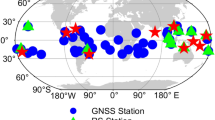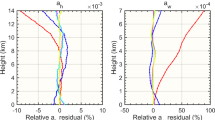Abstract
The study of the vertical variation of refractive power in the troposphere is necessary for the planning of radio systems. The variation of the atmospheric refractive power in the troposphere is one aspect that affects the propagation of electromagnetic waves and therefore the performance of links and communication systems. In this study, the 10-year (2008–2017) meteorological data (pressure, temperature, and humidity) from five major cities in Pakistan was used to calculate the radio refractive power. Over the entire period, the monthly average data was simulated through MATLAB to calculate radio refractivity. This work aimed to estimate the statistical variation of radio refraction due to meteorological factors, depending on the geographical area considered. The tropospheric radio refractivity results were obtained taking into account the height of the site and the height of scale parameter. The effect of temperature, pressure, and humidity on radio refraction was analyzed over 10 years (2008–2017) for five major cities of Pakistan, namely, Karachi, Quetta, Lahore, Islamabad, and Peshawar. It was revealed that the variation of radio refractive power and atmospheric pressure is higher in the rainy season than in the dry season, whereas the results indicated that the radio refractivity increased with a decrease in temperature and vice versa. The maximum relative humidity was observed as 75, 77, 89, 64, and 77 in Karachi, Lahore, Islamabad, Quetta, and Peshawar respectively, whereas the tropospheric refractivity was observed as 384, 389, 383, 437, and 378 respectively. This study found that the effect of humidity on radio refractivity is more than temperature and pressure.






Similar content being viewed by others
References
Adediji AT, Ajewole M (2008) Vertical profile of radio refractivity gradient in Akure South-West Nigeria. Prog Electromagn Res C 4:157–168
Adeyemi B (2006) Surface water vapor density and tropospheric radio refractivity linkage over three stations in Nigeria. J Atmos Solar Terr Phys 68(10):1105–1115
Afolabi LO, Seluwa EO, Shogo OE, Adebayo K (2018) MONTHLY CLASSIFICATION OF TROPOSPHERIC REFRACTION AND DUCT HEIGHT NEAR SEA–LEVEL, LAGOS STATE OF NIGERIA. Annals of the Faculty of Engineering Hunedoara 16(1):81–86
Agbo EP, Ettah EB, Eno EE (2021) The impacts of meteorological parameters on the seasonal, monthly, and annual variation of radio refractivity. Indian J Phys 95(2):195–207
Akpootu DO, Iliyasu MI (2017) Estimation of tropospheric radio refractivity and its variation with meteorological parameters over Ikeja, Nigeria. Journal of Geography, Environment and Earth Science International 10(1):1–12
Ayekomilogbon Olufemi, T., Famoriji John, O., & Olasoji Yekeen, O. (2013). Evaluation and modelling of UHF radiowave propagation in a forested environment. Evaluation, 2(12).
Bawa M, Galadanci GSM, Ayantunji BG, Mai-Unguwa H, Muhammad MT, Umar I (2017) Variation of meteorological parameters and its effect on refractive index of air over Lagos Nigeria. Bayero Journal of Pure and Applied Sciences 10(2):222–225
Bean, B. R. (1966). A world atlas of atmospheric radio refractivity (Vol. 52). US Government Printing Office.
Chinelo, I. U., & Chukwunike, O. C. (2016). The study of surface radio refractivity in Awka, south eastern Nigeria. Journal of Geography, Environment and Earth Science International, 1–7.
Corstanje, A., Bonardi, A., Buitink, S., Falcke, H., Hörandel, J. R., Mitra, P., ... & Winchen, T. (2017). The effect of the atmospheric refractive index on the radio signal of extensive air showers. Astroparticle Physics, 89, 23-29.
Elijah O, Rahim SKA, Sittakul V, Al-Samman AM, Cheffena M, Din JB, Tharek AR (2021) Effect of weather condition on LoRa IoT communication technology in a tropical region: Malaysia. IEEE Access 9:72835–72843
Frazier, W. E. (1984). Handbook of radio wave propagation loss (100–10,000 MHz). Unknow.
Freeman, R. L. (2006). Radio system design for telecommunications (Vol. 98). John Wiley & Sons.
Freeman, R.L. (2007), “Radio System Design for Telecommunications”, Third Edition, John Wiley and Sons, Chapters 1`,5. January.
Ford, B. W. (1996). Atmospheric refraction: how electromagnetic waves bend in the atmosphere and why it matters. US Navy.
Gao J, Brewster K, Xue M (2008) Variation of radio refractivity with respect to moisture and temperature and influence on radar ray path. Adv Atmos Sci 25(6):1098–1106
Gates, D. M. (1959). Preliminary Results of the National Bureau of Standards Radio and Ionospheric Observations During the Inter. Journal of Research-National Bureau of Standards: Mathematics and mathematical physics, 63.
Gough MW (1979) UHF signal strength measurements as a guide to atmospheric structures. Marconi Review 42:135–152
Gunashekar, S. D. (2006). An investigation of the propagation of 2 GHz radio waves over sea paths. University of Leicester (United Kingdom).
Hall, M. P. M. (1979). Effects of the troposphere on radio communication, IEE Electromagn. Wave Ser, 8.
Hitney H, Vieth R (1990) Statistical assessment of evaporation duct propagation. IEEE Trans Antennas Propag 38(6):794–799
Patterson, W. L., Hattan, C. P., Hitney, H. V., Paulus, R. A., & Lindem, G. E. (1994). Engineer’s Refractive Effects Prediction System (EREPS) Version 3.0. NAVAL COMMAND CONTROL AND OCEAN SURVEILLANCE CENTER RDT AND E DIV SAN DIEGO CA.
Recommendation, I. T. U. R. (1997). The radio refractive index: its formula and refractivity data.
Serdega V, Ivanovs G (2007) Refraction seasonal variation and that influence on to GHz range microwaves availability. Elektronika Ir Elektrotechnika 78(6):39–42
Shabana, A. A. (2011). Design of a satellite RF receiver at Ku-Band for tropical region (Doctoral dissertation, INTERNATIONAL ISLAMIC UNIVERSITY MALAYSIA).
Waverman L, Meschi M, Fuss M (2005) The impact of telecoms on economic growth in developing countries. The Vodafone Policy Paper Series 2(03):10–24
Žilinskas M, Tamošiunas S, Tamošiunaite M, Tamošiuniene M (2011) Yearly, seasonal and daily variations of radio refractivity. Physical Aspects of Microwave and Radar Applications 119(4):423
Author information
Authors and Affiliations
Corresponding author
Ethics declarations
Ethical Approval
The requirements of the ethical standards have been met.
Informed Consent
All authors have given their consent for their research to be published in this journal.
Competing Interests
The authors declare no competing interests.
Additional information
Publisher's Note
Springer Nature remains neutral with regard to jurisdictional claims in published maps and institutional affiliations.
Rights and permissions
About this article
Cite this article
Ilyas, S.Z., Hassan, A., Bibi, N. et al. Evaluation of Radio Refractivity in the Troposphere Over the Big Cities of Pakistan. J geovis spat anal 6, 3 (2022). https://doi.org/10.1007/s41651-022-00101-5
Accepted:
Published:
DOI: https://doi.org/10.1007/s41651-022-00101-5




